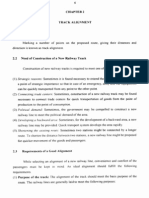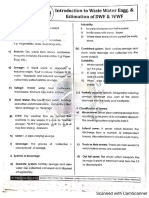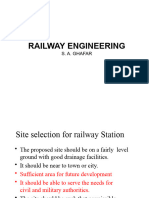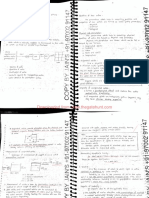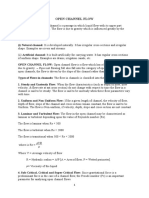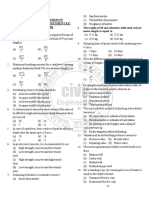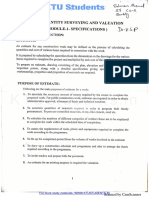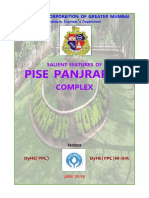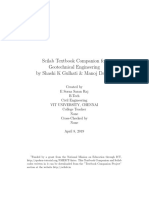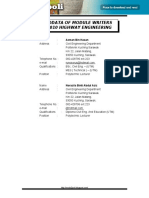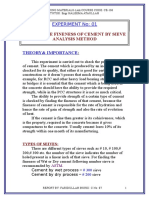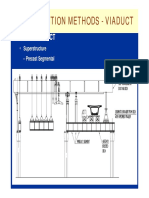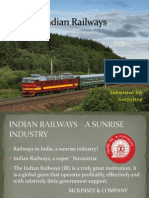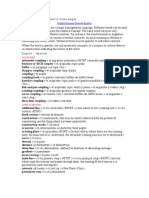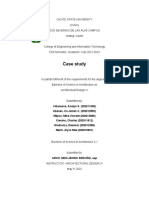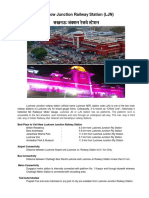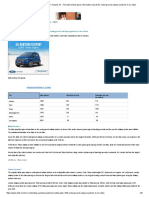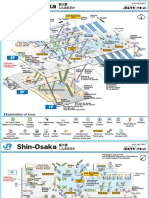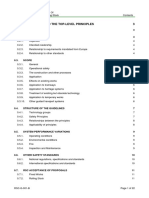Railway Engineering BEU PYQ
Uploaded by
ROUVINSH RAJRailway Engineering BEU PYQ
Uploaded by
ROUVINSH RAJRailway Engineering BEU PYQ (Previous Years Question Paper) 2022
Visit- Eazywey.com for other Subject PYQ Solution
1. Choose the correct answer of the following (any seven):
(a) In India, the first train was run between
(i) Bombay and Calcutta
(ii) Delhi and Bombay
(iii) Delhi and Calcutta
(iv) Bombay and Thane ✓
👉 Click here to Visit EazyWey.com
Railway Engineering BEU PYQ (Previous Years Question Paper) 2022
Visit- Eazywey.com for other Subject PYQ Solution
(b) The broad gauge is _____ wide.
(i) 80-95 cm
(i) 76-05 cm
(ii) 100-0 cm
(iv) 167-6 cm ✓
(c) Nowadays, the rail section on Indian railway is
(i) double headed
(ii) bull headed
(ii) dumbbell type
(iv) flat footed ✓
d) Between two sleepers, the minimum space for the
packing provided is
(i) 25 cm to 30 cm
(ii) 30 cm to 35 cm ✓
(i) 35 cm to 40 cm
(iv) 40 cm to 45 cm
👉 Click here to Visit EazyWey.com
Railway Engineering BEU PYQ (Previous Years Question Paper) 2022
Visit- Eazywey.com for other Subject PYQ Solution
(e) Nowadays the size of ballast used on Indian railway steel
sleepers is
(i) 2.5 cm ✓
(ii) 3.8 cm
(iii) 4-5 cm
(iv) 5-0 cm
(f) To connect one pair of fishplates, the number of bolts
used is
(i) 2
(ii) 4 ✓
(iii) 6
(iv) 8
(g) On Indian railways, max cant deficiency allowed on BG
tracks is
(i) 56 mm
(ii) 66 mm
👉 Click here to Visit EazyWey.com
Railway Engineering BEU PYQ (Previous Years Question Paper) 2022
Visit- Eazywey.com for other Subject PYQ Solution
(iii) 75 mm
(iv) 87 mm
Correct Answer = 7.6 cm or 76mm
Concept:-
The actual cant provided on a railway track is based on the
average speed of trains. However, in case of high speed
trains cant requirement will be more that the actual value
of cant provided so that train will be forced to move on a
lower value of cant then maximum cant is required for high
speed train. This deficiency in cant for high speed trains is
called cant deficiency.
The maximum permissible limit of cant deficiency is given
below in tabulated form different type of railway gauges:
👉 Click here to Visit EazyWey.com
Railway Engineering BEU PYQ (Previous Years Question Paper) 2022
Visit- Eazywey.com for other Subject PYQ Solution
(h) The maximum gradient of BG in station yards is
(i) 1 in 1000
(ii) 1 in 400 ✓
(iii) 1 in 500
(iv) 1 in 200
(i) The thin edge of tongue rail is called as
(i) heel
(ii) switch
(iii) toe ✓
(iv) None of the above
(j) Under the charge of a ganger, the track length is
(i) 1 km to 2 km
(ii) 3 km to 5 km ✓
(iii) 5 km to 6 km
(iv) 10 km to 15 km
👉 Click here to Visit EazyWey.com
Railway Engineering BEU PYQ (Previous Years Question Paper) 2022
Visit- Eazywey.com for other Subject PYQ Solution
Q.2 Explain what is meant by track capacity and discuss
important measures for increasing the line capacity.
Answer:- Track capacity refers to how many trains or vehicles can fit on a
railway track at the same time. Increasing track capacity means allowing
more trains to use the track, which makes the transportation system more
efficient.
To increase track capacity, there are some important things that can be
done:
1. Improve the track: Make the track better by adding more tracks or
improving the ones already there. This helps trains move more smoothly
and reduces delays.
2. Use better signaling systems: Install modern signaling systems that
control the movement of trains. These systems make it safer for trains to
be closer together, which means more trains can use the track.
3. Plan train schedules carefully: Plan when trains should leave and arrive
to avoid conflicts and delays. This helps make sure trains can move
smoothly and efficiently.
4. Make platforms and sidings longer: Extend the areas where trains stop
and park. This allows longer trains to fit, which means more people or
goods can be carried on each train.
5. Take good care of the track: Regularly maintain the track and equipment
to prevent problems. This helps avoid disruptions and keeps the track in
good condition.
6. Coordinate timetables with other railways: Plan train schedules to work
well with other railways. This helps manage train movements and increases
the overall capacity of the track.
👉 Click here to Visit EazyWey.com
Railway Engineering BEU PYQ (Previous Years Question Paper) 2022
Visit- Eazywey.com for other Subject PYQ Solution
7. Improve communication and control systems: Make sure everyone
involved can communicate well and control train movements effectively.
This helps with coordination and makes the system work better.
8. Find ways to operate more efficiently: Use smart ways to manage trains,
like dispatching them in the best way or minimizing the time they spend at
stations. This helps increase the track's capacity.
Increasing track capacity requires considering different factors like
money, physical limitations, existing infrastructure, and expected demand.
It's important to take a comprehensive approach and combine different
measures to achieve the best results.
Q.3(a)- What are various types of the stresses induced in the
railway track? Explain in brief.
Answer:- The railway track experiences different types of stresses caused
by the forces and loads it faces. These stresses can affect the track's
stability and performance. Here are the main types of stresses in a railway
track, explained in simple terms:
1. Vertical Stress: This stress occurs because of the weight of the train and
the things it carries. The weight puts pressure on the track, which can lead
to track settling or deformation if it's too much.
2. Lateral Stress: Lateral stress happens when the train moves sideways on
the track. It creates forces that push against the sides of the track. This
stress can cause the track to bend or wear out faster, especially on curved
sections.
3. Longitudinal Stress: Longitudinal stress is caused by the train's
acceleration or braking forces. These forces push or pull the track in the
direction of the train's movement. If the stress is too high, it can damage
the track or cause it to become misaligned.
4. Torsional Stress: Torsional stress occurs when the track twists due to the
forces applied to it. This stress is most noticeable in curved sections or
👉 Click here to Visit EazyWey.com
Railway Engineering BEU PYQ (Previous Years Question Paper) 2022
Visit- Eazywey.com for other Subject PYQ Solution
switches. Excessive torsional stress can lead to rail damage or
misalignment.
5. Thermal Stress: Thermal stress is caused by changes in temperature.
When the temperature changes, the track expands or contracts, creating
stress. Extreme temperature changes can cause the track to buckle or
form gaps.
6. Impact Stress: Impact stress happens when the train passes over joints
or uneven parts of the track. The forces generated during these moments
can cause wear and damage to the track.
To manage these stresses, track designers and maintenance crews use
various techniques. They reinforce the track, use resilient materials, and
regularly inspect for any issues. These measures help ensure that the track
remains safe and reliable for train operations.
Q.3(b)- Explain the necessity of sleepers in railway track. What
are the desirable qualities or requirements of good sleepers?
Answer:- Sleepers, also known as railroad ties, are an integral component
of railway tracks. They are rectangular or trapezoidal-shaped beams
placed horizontally underneath the rails to support and distribute the
weight of the train. The necessity of sleepers in railway tracks can be
understood through the following points:
1. Load Distribution: Sleepers help spread the weight of the train and rails
over a larger area. This prevents too much pressure on the ground and
keeps the track stable.
2. Track Stability: Sleepers keep the rails in place and prevent them from
moving sideways. This helps maintain the track's alignment and keeps the
distance between the rails (gauge) correct.
👉 Click here to Visit EazyWey.com
Railway Engineering BEU PYQ (Previous Years Question Paper) 2022
Visit- Eazywey.com for other Subject PYQ Solution
3. Vibration Absorption: Trains create vibrations when they move. Sleepers
help absorb these vibrations, making the ride smoother for passengers
and reducing damage to the track.
4. Durability: Good sleepers last a long time and can withstand different
weather conditions. They should not rot or decay easily.
5. Easy Installation and Maintenance: Sleepers should be easy to install
and replace if needed. They should also require minimal maintenance to
keep the track in good shape.
Qualities of good sleepers include:
1. Strength: Sleepers should be strong enough to handle heavy loads and
not break or bend under the weight of the train.
2. Durability: They should resist damage from the environment, insects, or
decay. Materials like treated wood or concrete are commonly used for this
reason.
3. Stability: Sleepers should keep their shape and size even with the train's
movement. This ensures the track remains stable and aligned properly.
4. Resistance to Movement: Sleepers should not move sideways over time.
This reduces the need for frequent adjustments to keep the track in place.
5. Easy to Secure: Sleepers should have features that make it easy to
attach and secure the rails to them. This ensures the rails stay in the right
position.
By meeting these requirements, sleepers help create a safe and reliable
railway track that can handle the weight of trains and provide a smooth
ride for passengers.
👉 Click here to Visit EazyWey.com
Railway Engineering BEU PYQ (Previous Years Question Paper) 2022
Visit- Eazywey.com for other Subject PYQ Solution
Q.4(a)- What is the ballast in permanent way? Mention the
function of ballast and state the requirements of a good ballast
material.
Answer:- Ballast is a layer of coarse stones or gravel placed under and
around the sleepers in railway tracks. It serves several functions and has
specific requirements.
Function of Ballast:
1. Load Distribution: Ballast spreads the weight of trains and track
infrastructure over a larger area, keeping the track stable and preventing
excessive pressure.
2. Drainage: Ballast allows water to drain away from the track, preventing
waterlogging and maintaining the track's strength.
3. Track Stability: Ballast holds the sleepers in place, keeping the track
properly aligned and preventing movement during train operations.
4. Vibration Absorption: Ballast acts as a cushion, absorbing vibrations
generated by trains and providing a smoother ride for passengers.
Requirements of a Good Ballast Material:
1. Size and Gradation: The ballast should consist of stones or gravel that
are of uniform size and well-graded. This helps create a stable and
interlocking layer.
2. Drainage: The ballast material should allow water to flow through easily,
preventing water buildup and maintaining good drainage.
3. Durability: The ballast should be strong and resistant to wear, abrasion,
and degradation caused by trains and the environment. This ensures it
lasts longer without needing frequent replacement.
4. Stability: The ballast material should stay in place and not deform or
settle under the weight of trains, keeping the track aligned and stable.
👉 Click here to Visit EazyWey.com
Railway Engineering BEU PYQ (Previous Years Question Paper) 2022
Visit- Eazywey.com for other Subject PYQ Solution
5. Cleanliness: The ballast should be free from unwanted materials like clay
or organic matter that could clog drainage and reduce its effectiveness.
6. Availability and Cost-effectiveness: It should be easily accessible and
economically feasible for use in railway track construction and
maintenance.
By meeting these requirements, the right ballast material helps maintain a
stable, well-drained, and durable railway track.
Q.4(b)- Explain, with neat sketches, how surface and subsurface
water can be removed from a railway track.
Answer:- Simplified explanation of how surface and subsurface water can
be removed from a railway track:
1. Surface Water Drainage:
To remove water from the surface of a railway track:
a. Shape the Track: The track is built with a slight slope, higher in the
center and lower on the sides. This allows water to flow away from the track
and prevents pooling.
b. Install Cross Drains: Drainage channels or pipes called cross drains are
placed across the track at regular intervals. They collect water from the
track surface and direct it away through outlets or pipes.
c. Shape the Ballast: The ballast layer beneath the track is shaped with a
slight hump in the center. This helps water to drain towards the edges and
prevents it from collecting on the track.
2. Subsurface Water Drainage:
To remove water beneath the track:
a. Use Drainage Pipes: Perforated pipes are placed under the track to
collect and drain water from beneath. These pipes are installed in
👉 Click here to Visit EazyWey.com
Railway Engineering BEU PYQ (Previous Years Question Paper) 2022
Visit- Eazywey.com for other Subject PYQ Solution
trenches filled with coarse gravel or stones, allowing water to flow into
them.
b. Create French Drains: Trenches filled with porous materials like gravel
are built alongside the track. They allow water from the ground to enter
and drain away through the gravel.
c. Improve Subsoil Drainage: Techniques like adding special layers or
stabilizing the soil can help improve drainage and prevent excess water
from reaching the track.
Note:- specific methods may vary depending on factors like location and
soil conditions.
Q.5(a)- Describe the factors that influence the selection of the
site for a railway station. How are the railway stations
classified?
Answer:- The selection of a site for a railway station is influenced by
various factors that take into account the convenience and safety of
passengers, operational requirements, and integration with the
surrounding transportation network. The following are the key factors
considered in selecting a site for a railway station:
1. Population and Demand: The station should be located where there is
enough population or passenger demand to justify its presence and
ensure a sufficient number of users.
2. Accessibility: The site should be easily reachable for the surrounding
population with good connections to roads, public transportation, and
other modes of travel. It should be located in a central or convenient
location.
3. Land Availability: There should be enough land for the station,
platforms, parking lots, and passenger facilities. Sufficient space is
necessary to accommodate current and future needs.
👉 Click here to Visit EazyWey.com
Railway Engineering BEU PYQ (Previous Years Question Paper) 2022
Visit- Eazywey.com for other Subject PYQ Solution
4. Safety: The site should be safe for passengers and operations, with
proper road access, pedestrian facilities, and emergency response
provisions.
5. Integration with Transport Network: The station should be
well-connected to other modes of transportation like buses, taxis, and
other rail lines, allowing for easy transfers and multi-modal travel options.
6. Economic Feasibility: The construction and operation of the station
should make economic sense, considering factors like potential revenue,
expected passenger traffic, and opportunities for commercial
development.
7. Environmental Impact: Environmental factors such as minimizing
disruption to natural habitats, reducing noise pollution, and promoting
sustainability should be taken into account.
Classification of Railway Stations:
Railway stations can be classified based on various criteria, including their
importance, facilities, and services offered. Common classification systems
include:
1. Based on Importance:
- Major Stations: Large stations in major cities or hubs with a wide range
of facilities and serving as major transportation centers.
- Intermediate Stations: Stations located between major stations, providing
necessary facilities but with fewer services and amenities.
2. Based on Function:
- Terminus Stations: Stations at the end of a rail line where trains start or
terminate their journeys.
- Junction Stations: Stations where two or more rail lines intersect, allowing
for transfers and connections.
3. Based on Services and Facilities:
- Passenger Stations: Stations primarily serving passenger traffic, offering
ticketing, waiting areas, platforms, and other passenger amenities.
👉 Click here to Visit EazyWey.com
Railway Engineering BEU PYQ (Previous Years Question Paper) 2022
Visit- Eazywey.com for other Subject PYQ Solution
- Freight Stations: Stations dedicated to handling freight and cargo
operations.
Q.5(b)- What are the design details in a symmetrical split?
Answer:- A symmetrical split is a type of track design where a railway track
divides into two paths. The design details of a symmetrical split include:
1. Switches: These are movable rails that allow trains to change from one
track to another. In a symmetrical split, there are two sets of switches, one
for each path.
2. Stock Rails: These are the fixed rails that form the main path for trains. In
a symmetrical split, there are two stock rails, each aligned with one of the
diverging paths.
3. Tongue Rails: These are movable rails that guide the train wheels onto
the desired path. In a symmetrical split, there are two sets of tongue rails,
one for each switch.
4. Frog: This is a diamond-shaped crossing point where the two diverging
paths intersect. It allows trains to transition smoothly from the stock rails
to the diverging tracks.
5. Guard Rails: These are fixed rails located near the frog to guide the train
wheels and prevent derailments. They ensure that the wheels stay on track
when passing through the frog.
6. Check Rails: These are additional rails positioned next to the stock rails
and tongue rails. They help guide the train wheels and prevent excessive
sideways movement.
7. Closure Rails: These are short sections of rail that connect the diverging
tracks back to the mainline after the frog. They complete the symmetrical
split and ensure a smooth transition back to the main track.
👉 Click here to Visit EazyWey.com
Railway Engineering BEU PYQ (Previous Years Question Paper) 2022
Visit- Eazywey.com for other Subject PYQ Solution
Q.6(a)- What is creep? Discuss the theories propounded to
explain probable causes of creep.
Answer:- Creep, in the context of railway tracks, refers to the longitudinal
movement or displacement of the rails over time. It is a phenomenon where
the rails gradually shift in the direction of train movement due to various
factors. Several theories have been proposed to explain the probable
causes of creep:
1. Thermal Expansion Theory: According to this theory, changes in
temperature cause the rails to expand or contract. When the temperature
rises, the rails expand, and when it decreases, they contract. These
temperature-induced changes can lead to the rails shifting longitudinally
and causing creep.
2. Residual Stresses Theory: This theory suggests that residual stresses
from the track construction process contribute to creep. These stresses
can result from rail manufacturing, welding, or track curvature. Over time,
these stresses can cause the rails to slowly move and result in creep.
3. Wheel-Rail Interaction Theory: The interaction between the train's wheels
and the rails is another factor in creep. The dynamic forces and vibrations
generated when trains pass over the track can lead to longitudinal
movement of the rails.
4. Ballast Consolidation Theory: According to this theory, creep occurs due
to the settling and consolidation of the ballast layer beneath the track.
Over time, the ballast particles rearrange and compact, causing the rails
to shift longitudinally.
5. Track Lateral Resistance Theory: This theory emphasizes the importance
of proper lateral stability of the track. Inadequate fastening, poor track
maintenance, or track geometry issues can reduce the track's lateral
resistance, allowing the rails to move longitudinally.
👉 Click here to Visit EazyWey.com
Railway Engineering BEU PYQ (Previous Years Question Paper) 2022
Visit- Eazywey.com for other Subject PYQ Solution
Q.6(b)- What is MSP? Give its relative merits and demerits as
compared to other methods of track maintenance.
Answer:- MSP stands for Maintenance of Way with Small Packages, which is
a method of track maintenance used in the railway industry. It involves the
use of smaller work crews equipped with specialized machines and tools to
perform track maintenance tasks efficiently. Here are the relative merits
and demerits of MSP compared to other methods of track maintenance:
Merits of MSP:
1. Cost-Efficiency: MSP can be cost-effective compared to traditional
large-scale maintenance methods. By utilizing smaller work crews and
specialized equipment, it reduces labor and equipment costs.
2. Flexibility: MSP offers flexibility in scheduling and execution. Smaller work
crews can be deployed more quickly and easily, allowing for timely
maintenance and quicker response to track issues.
3. Minimized Disruption: MSP minimizes disruption to train operations.
With smaller crews, work can be completed in shorter durations, reducing
the need for extended track closures and disruptions to train services.
4. Enhanced Productivity: MSP utilizes specialized machines and tools
designed for specific maintenance tasks, leading to increased productivity
and efficiency in track maintenance operations.
5. Targeted Maintenance: With MSP, maintenance efforts can be targeted
to specific areas or sections of the track that require immediate attention.
This focused approach helps address specific issues promptly and
efficiently.
Demerits of MSP:
1. Limited Scope: MSP may not be suitable for large-scale track
maintenance projects or major rehabilitation work. It is more effective for
routine maintenance tasks and smaller-scale repairs.
👉 Click here to Visit EazyWey.com
Railway Engineering BEU PYQ (Previous Years Question Paper) 2022
Visit- Eazywey.com for other Subject PYQ Solution
2. Skill Requirements: MSP requires skilled and experienced operators to
handle specialized machinery and tools. Adequate training and expertise
are necessary to ensure safe and efficient operations.
3. Equipment Limitations: The use of specialized machines and tools in
MSP may have limitations in terms of capabilities and scope. Certain
maintenance tasks may still require larger equipment or manual labor.
4. Reduced Versatility: Smaller machines and crews used in MSP may have
limitations in adapting to different track conditions or complex
maintenance scenarios, which may necessitate other methods or
approaches.
5. Dependency on Technology: MSP relies on specialized machinery and
technology for efficient operations. Any technical failures or equipment
breakdowns can impact the maintenance process and may require
additional resources to address.
Q.7- What is the necessity of geometric design of a railway
track? Enumerate the significant features of design of a railway
track.
Answer:- The geometric design of a railway track is essential to ensure safe
and efficient train operations. It involves determining the alignment,
curvature, gradients, and other geometric features of the track. Here's why
it is necessary and some key features of track design:
1. Safety: Geometric design ensures that the track is safe for trains to travel
on. Factors like the alignment of the track, curvature of the track in curves,
and the slopes or gradients of the track are carefully considered to
minimize the risk of accidents or derailments.
2. Smooth Train Movement: A well-designed track allows trains to move
smoothly and comfortably. This is achieved by considering factors such as
👉 Click here to Visit EazyWey.com
Railway Engineering BEU PYQ (Previous Years Question Paper) 2022
Visit- Eazywey.com for other Subject PYQ Solution
the alignment of the track, curves, and slopes. A smoother ride improves
passenger comfort and reduces wear and tear on the track and trains.
3. Speed and Capacity: Geometric design plays a role in determining the
maximum speed and capacity of the track. By optimizing the alignment,
curves, and gradients, higher speeds can be achieved, and the track's
capacity to handle more trains can be increased.
4. Train Stability: Proper design features, such as balanced banking (tilting)
on curves, ensure that trains remain stable during turns. This reduces the
chances of trains tipping over or becoming unstable on curved sections.
5. Maintenance and Track Life: The geometric design of the track affects
maintenance requirements and the overall lifespan of the track. A
well-designed track makes maintenance activities more efficient, reduces
wear and tear, and extends the track's lifespan.
Significant features of track design include:
1. Alignment: Determining the straight sections and curves of the track to
ensure safe and efficient train movement.
2. Curvature: Designing curves with appropriate sizes to minimize forces
on trains and maintain stability.
3. Gradient: Establishing slopes along the track to facilitate train
movement and energy efficiency.
4. Superelevation: Tilting the track on curves to counteract the sideways
force on trains and improve stability.
5. Cross-sectional Design: Defining the shape and dimensions of the track,
including rail gauge, ballast depth, and shoulder width, for proper
support, drainage, and stability.
6. Transition Curves: Incorporating smooth transitions between straight
sections and curves to ensure a comfortable ride.
👉 Click here to Visit EazyWey.com
Railway Engineering BEU PYQ (Previous Years Question Paper) 2022
Visit- Eazywey.com for other Subject PYQ Solution
7. Clearances: Determining the space required between the track and
structures like platforms, bridges, tunnels, and overhead lines for safe
train operations.
By considering these design features, the geometric design of a railway
track aims to create a safe and efficient infrastructure for train travel.
Q.8- Why is the uniformity of gauge desirable in any country?
Mention the demerits of non-uniformity of gauges.
Answer:- The uniformity of gauge, which refers to the consistent width
between railway tracks, is highly desirable in any country for several
reasons. Here's why uniformity of gauge is important, along with the
drawbacks of non-uniformity:
Advantages of Uniform Gauge:
1. Easy Movement: A uniform gauge allows trains to travel smoothly across
different regions without the need for gauge changes or transfers. It saves
time and enables efficient transportation.
2. Faster and Efficient: Trains can maintain higher speeds and schedules
with a uniform gauge, leading to faster travel times and improved
productivity.
3. Economic Benefits: Uniform gauge promotes trade and economic
development by facilitating the transport of goods across regions. It
encourages investment and economic integration within the country.
4. Simplified Infrastructure: A uniform gauge simplifies the design and
construction of railway infrastructure, reducing costs and complexity.
5. Interchangeability: Trains and rolling stock from different regions can be
easily interchanged, providing flexibility and efficient logistics.
Demerits of Non-Uniform Gauge:
👉 Click here to Visit EazyWey.com
Railway Engineering BEU PYQ (Previous Years Question Paper) 2022
Visit- Eazywey.com for other Subject PYQ Solution
1. Limited Connectivity: Different gauges create barriers in railway
networks, making direct travel between regions difficult. It requires
time-consuming gauge changes or cargo transfers.
2. Increased Costs: Non-uniform gauges add complexity and costs to
railway operations, requiring specialized equipment and infrastructure.
3. Inefficiency and Delays: Trains on non-uniform gauges face delays and
reduced efficiency due to gauge changes and slower speeds.
4. Limited Capacity: Non-uniform gauges restrict the network's capacity,
leading to congestion and bottlenecks at gauge-changing points.
5. Fragmentation and Incompatibility: Non-uniform gauges fragment the
network and create compatibility issues between different gauge systems.
To avoid these drawbacks, countries aim for a uniform gauge within their
railway networks. It promotes easy movement, efficiency, economic growth,
and reduces costs and complexities.
Q.9- Write short notes on (any four):
(a) Factors in gauge selection for a new track
(b) Track capacity
(c) Chock sleeper
(d) Selection of ballast materials
(e) Cross-drainage
(f) Retarders
Answer:- (a) Factors in gauge selection for a new track:
👉 Click here to Visit EazyWey.com
Railway Engineering BEU PYQ (Previous Years Question Paper) 2022
Visit- Eazywey.com for other Subject PYQ Solution
When selecting the gauge (track width) for a new track, several factors
need to be considered:
1. Compatibility: The chosen gauge should be compatible with the existing
railway network to ensure seamless connectivity and interoperability.
2. Passenger and Freight Requirements: The expected volume and type of
traffic, such as passenger trains or heavy freight, influence the gauge
selection. Larger gauges can accommodate higher loads and provide
more space for passengers and cargo.
3. Cost and Resources: The cost of construction, availability of materials,
and the resources required for track maintenance are important factors.
Opting for a standard gauge that is widely used can help reduce costs
and ensure the availability of equipment and spare parts.
4. Future Expansion: Anticipating future growth and potential network
expansion is crucial. Selecting a gauge that allows for future upgrades or
integration with neighboring networks can prevent costly gauge
conversion later on.
(b) Track capacity:
Track capacity refers to the maximum number of trains or amount of
traffic that a railway track can handle within a given time period. Several
factors influence track capacity, including:
1. Track Configuration: The design and layout of tracks, such as the
number of tracks, sidings, and signaling systems, impact capacity. Multiple
tracks and efficient signaling allow for more trains to operate
simultaneously.
2. Train Speed and Headway: The speed at which trains travel and the
minimum safe distance maintained between them (headway) affect
capacity. Higher speeds and shorter headways increase capacity but
require advanced signaling and train control systems.
👉 Click here to Visit EazyWey.com
Railway Engineering BEU PYQ (Previous Years Question Paper) 2022
Visit- Eazywey.com for other Subject PYQ Solution
3. Infrastructure Condition: The condition of the track, including its
alignment, curves, gradients, and quality of ballast and sleepers, affects
capacity. Well-maintained infrastructure allows for smoother and faster
train movements.
4. Signaling and Control Systems: Efficient signaling and train control
systems optimize capacity by ensuring safe train separation, minimizing
delays, and facilitating smooth traffic flow.
(c) Chock sleeper:
A chock sleeper, also known as a block sleeper or sole plate, is a
component used in railway track construction. It is a rectangular or
trapezoidal-shaped plate made of wood, concrete, or steel placed under
the base of a rail to provide additional support and stability. The main
purpose of chock sleepers is to distribute the load from the rail to the
underlying ballast or substructure.
Chock sleepers offer several advantages:
1. Stability: By providing a broader base for the rail, chock sleepers
enhance the stability and alignment of the track.
2. Load Distribution: They help distribute the weight of passing trains more
evenly across the underlying ballast or substructure, preventing excessive
stress on the track components.
3. Reduced Maintenance: Chock sleepers can improve track durability and
reduce the frequency of maintenance by minimizing track deformations
and irregularities.
4. Noise and Vibration Reduction: The use of chock sleepers can help
reduce noise and vibrations generated by train movements, enhancing the
comfort of passengers and nearby residents.
(d) Selection of ballast materials:
👉 Click here to Visit EazyWey.com
Railway Engineering BEU PYQ (Previous Years Question Paper) 2022
Visit- Eazywey.com for other Subject PYQ Solution
Ballast is the layer of crushed stones or rocks placed beneath railway
tracks to provide support, stability, and drainage. When selecting ballast
materials, the following factors are considered:
1. Strength and Durability: Ballast materials should be strong enough to
withstand the loads exerted by trains and durable enough to resist
degradation over time.
2. Particle Size and Shape: The size and shape of ballast particles
influence their interlocking ability and stability. Irregularly shaped,
angular particles are preferred as they interlock better, providing greater
stability.
3. Drainage Properties: Ballast should have good drainage characteristics
to prevent water accumulation, which can soften the track foundation and
reduce stability. Porous or well-graded materials are preferred for effective
drainage.
4. Availability and Cost
: The availability of suitable ballast materials in the local area and their
cost play a significant role in selection. Locally sourced materials can help
reduce transportation costs.
(e) Cross-drainage:
Cross-drainage refers to the provision of structures or arrangements that
allow water to pass under railway tracks, roads, or other infrastructure at
locations where natural water bodies, such as rivers, streams, or drainage
channels, intersect with the track alignment.
The key purpose of cross-drainage structures is to ensure the
uninterrupted flow of water and prevent water accumulation, which can
damage the track or impede train operations. Common types of
cross-drainage structures include bridges, culverts, and underpasses.
These structures are designed to accommodate the expected water flow,
considering factors such as the size and velocity of water, the topography
👉 Click here to Visit EazyWey.com
Railway Engineering BEU PYQ (Previous Years Question Paper) 2022
Visit- Eazywey.com for other Subject PYQ Solution
of the area, and the anticipated frequency and intensity of rainfall. Proper
design and maintenance of cross-drainage structures are essential for the
safety and longevity of railway tracks.
(f) Retarders:
Retarders, also known as braking or deceleration devices, are used in
railway yards or sidings to control the speed and movement of rolling
stock (freight cars or wagons). They help slow down or stop the movement
of trains during sorting, classification, or marshaling operations.
Retarders function by applying a controlled braking force to the wheels of
the rolling stock, allowing for precise control of their speed and position.
They are typically equipped with electromechanical or hydraulic systems
that can be operated remotely or manually by yard operators.
The advantages of using retarders include:
1. Safety: Retarders enhance safety by providing controlled braking and
preventing excessive speeds or collisions in yard areas.
2. Efficiency: They improve the efficiency of train operations by allowing for
precise control and positioning of rolling stock during sorting or
marshaling activities.
3. Reduced Wear and Tear: By providing controlled deceleration, retarders
help reduce wear and tear on train components, such as brakes and
couplers.
4. Operator Convenience: Retarders make it easier for yard operators to
handle and organize rolling stock by providing reliable braking control.
Overall, retarders play a crucial role in ensuring safe and efficient
operations within railway yards.
👉 Click here to Visit EazyWey.com
You might also like
- Class Note Concrete Moddified 10 01 2069 PDFNo ratings yetClass Note Concrete Moddified 10 01 2069 PDF63 pages
- IES OBJ Civil Engineering 2003 Paper IINo ratings yetIES OBJ Civil Engineering 2003 Paper II16 pages
- CET 305 GT II (Question Paper and Scheme)No ratings yetCET 305 GT II (Question Paper and Scheme)43 pages
- Civil Engineering (Diploma Standard) : Subject Code: 299 Unit - I: Engineering MechanicsNo ratings yetCivil Engineering (Diploma Standard) : Subject Code: 299 Unit - I: Engineering Mechanics3 pages
- Numerical-02 of Khosla Theory From KR Arora Book100% (1)Numerical-02 of Khosla Theory From KR Arora Book11 pages
- Lec#1 Site Selection For Railway StationNo ratings yetLec#1 Site Selection For Railway Station123 pages
- 2nd Year Civil Engineering Course Detail of IOE, TU Nepal100% (1)2nd Year Civil Engineering Course Detail of IOE, TU Nepal20 pages
- Laspotech Lecture I On Hydraulic and Hydrology-1No ratings yetLaspotech Lecture I On Hydraulic and Hydrology-17 pages
- BHEL Supervisor Trainee Civil 12-04-25 PAPER @TEAMMCQNo ratings yetBHEL Supervisor Trainee Civil 12-04-25 PAPER @TEAMMCQ50 pages
- Public Service Commission Sub Asst. Engineers Recruitment Ex-Amination - 2001100% (1)Public Service Commission Sub Asst. Engineers Recruitment Ex-Amination - 20017 pages
- CE409 M1-Quantity Surveying and Valuation-Ktustudents - inNo ratings yetCE409 M1-Quantity Surveying and Valuation-Ktustudents - in17 pages
- Traffic Flow & Shockwave Theory AssignmentNo ratings yetTraffic Flow & Shockwave Theory Assignment4 pages
- KUET Class Note Project Planning & Construction ManagementNo ratings yetKUET Class Note Project Planning & Construction Management144 pages
- Industrial Training Report: Strengthening and Widening of Road HP PWD Sub-Division, Hatkoti, JubbalNo ratings yetIndustrial Training Report: Strengthening and Widening of Road HP PWD Sub-Division, Hatkoti, Jubbal39 pages
- Karnataka PWD - Compulsory - Kannada - QCANo ratings yetKarnataka PWD - Compulsory - Kannada - QCA36 pages
- Safety Guidelines for Pise Panjrapur ComplexNo ratings yetSafety Guidelines for Pise Panjrapur Complex25 pages
- A Guide To Civil Engineering Laboratory Calculations100% (1)A Guide To Civil Engineering Laboratory Calculations51 pages
- Traffic Signal Design and Traffic Engineering - DPP 01 Discussion NotesNo ratings yetTraffic Signal Design and Traffic Engineering - DPP 01 Discussion Notes17 pages
- CE8403 - 2M IQ QB - by WWW - EasyEngineering.net 1No ratings yetCE8403 - 2M IQ QB - by WWW - EasyEngineering.net 124 pages
- Scilab Guide for Geotechnical EngineeringNo ratings yetScilab Guide for Geotechnical Engineering106 pages
- CPM & PERT - Short Notes (English) - PDF OnlyNo ratings yetCPM & PERT - Short Notes (English) - PDF Only5 pages
- Construction Methods - Viaduct: Elevated Viaduct Elevated ViaductNo ratings yetConstruction Methods - Viaduct: Elevated Viaduct Elevated Viaduct45 pages
- Railway Engineering (2023) PYQ SolutionNo ratings yetRailway Engineering (2023) PYQ Solution23 pages
- Glossary of Terms Used in These Pages: English-Spanish Spanish-EnglishNo ratings yetGlossary of Terms Used in These Pages: English-Spanish Spanish-English23 pages
- Case Studies For Large Span Roofing StructureNo ratings yetCase Studies For Large Span Roofing Structure1 page
- Time Overrun in Transportation Project - A Case Study of Mumbai MonorailNo ratings yetTime Overrun in Transportation Project - A Case Study of Mumbai Monorail10 pages
- Sydney Metro-Preliminary Reference Concept of Operations100% (1)Sydney Metro-Preliminary Reference Concept of Operations29 pages
- The Table Below Gives Information About The Underground Railway Systems in Six CitiesNo ratings yetThe Table Below Gives Information About The Underground Railway Systems in Six Cities4 pages
- Section0-Introduction & Top Level PrinciplesNo ratings yetSection0-Introduction & Top Level Principles22 pages
